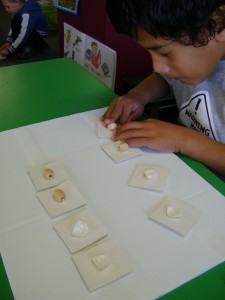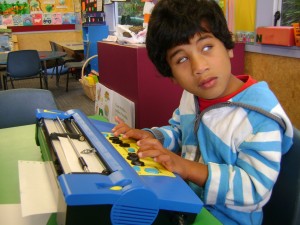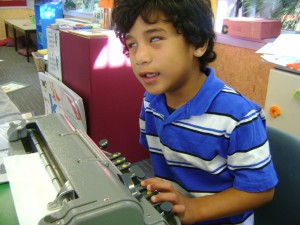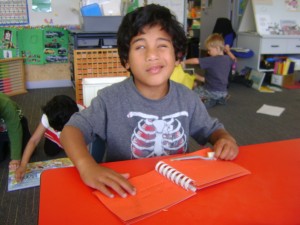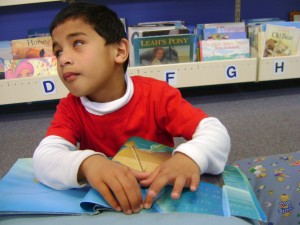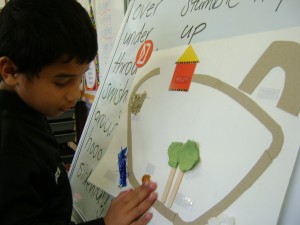Tearima is 5 years old and is learning to read and write. As he uses braille to access printed text, his preparation for literacy also includes an extensive programme to develop his tactile skills.
Rebecca Reed, the Resource Teacher Vision in Tearima’s education team, gives an overview of Tearima’s current literacy programme.
She also describes some of the ongoing, behind the scenes preparation that ensures that Tearima has equitable access to the curriculum.
Preparation for literacy in early childhood
As a pre-schooler, Tearima followed a comprehensive and extensive programme to develop his tactile discrimination and fine motor skills (see figure 1).
This focussed on preparing him for the task of learning braille as it would be his primary reading and writing medium.
Literacy experiences in the classroom
Tearima is rapidly becoming a competent user of grade 1 braille. His class uses the Jolly Phonics programme and with tactile adaptions, Tearima has participated alongside his peers.
To write braille at school, Tearima has his own Mountbatten brailler which he uses for all his writing.
The Mountbatten also offers many opportunities for incidental learning, such as braille short forms and contractions (short hand forms of braille).
The Mountbatten also has speech output. This function consistently increases Tearima’s engagement in writing (see figure 2).
Tearima also uses a mechanical Perkins brailler, if the Mountbatten is out of action or is a better tool for the job, e.g in maths.
Tearima’s writing programme is supported with an environment which has been flooded with both objects labeled in braille and extra tactile qualities.
Tearima has a large personal library of early reader books for reading during class time (see figure 4).
These are brailled at his reading level and have supportive tactile illustrations.
The Accessible Formats library at the Homai Campus also send regular supplies of tactile reading books for the school library.
This service enables Tearima to select reading books from the same library alongside with his classmates (see figure 5). The books are very attractive and particularly engaging for sighted peers.
Tearima also uses braille and his tactual skills to access other elements of the curriculum.
Recently, the class read the story, “Going on a Bear Hunt” and then painted a map which followed the movements of the family in the story.
Tearima made a tactile map to illustrate the journey and labels in braille were attached to identify the places (see figure 6).
Tearima followed the story on his map as the class did the same and he proudly presented his work at assembly and described it to the other students.
Useful Links
- Pre-Braille: Preparing the Child Who is Blind to Read – Paths to Literacy website.
- Instructional Strategies for Teaching Braille – Paths to Literacy website.
- Feel the Power of Literacy – YouTube.
- Braille Readiness Grid designed by Anne McComiskey from the Center for the Visually Impaired.
- Mountbatten Pro lessons from Special Education Technology British Colombia website.
Teaching and learning strategies and adaptations
Resources are fully adapted by the education team to enable Tearima to access the curriculum alongside his peers and to support concept development.
Teaching methods are continually adapted to meet Tearima’s visual and tactile needs and to support his participation and contribution in the classroom community.
Tearima’s classroom environment has been adapted for his safety and independence. Furniture is kept in the same place and classmates have become very responsible about keeping chairs tucked in and keeping the floor clear. Tearima has been able to develop a comprehensive mental map of his classroom and most of the school.
As Tearima speaks two languages, we are working to ensure that both are acknowledged and supported through out all aspects of the literacy programme.
More information
Email us at BLENNZ Online for more information.
We will link you up with either the author of this post or another BLENNZ colleague with whom you can continue your conversation.

